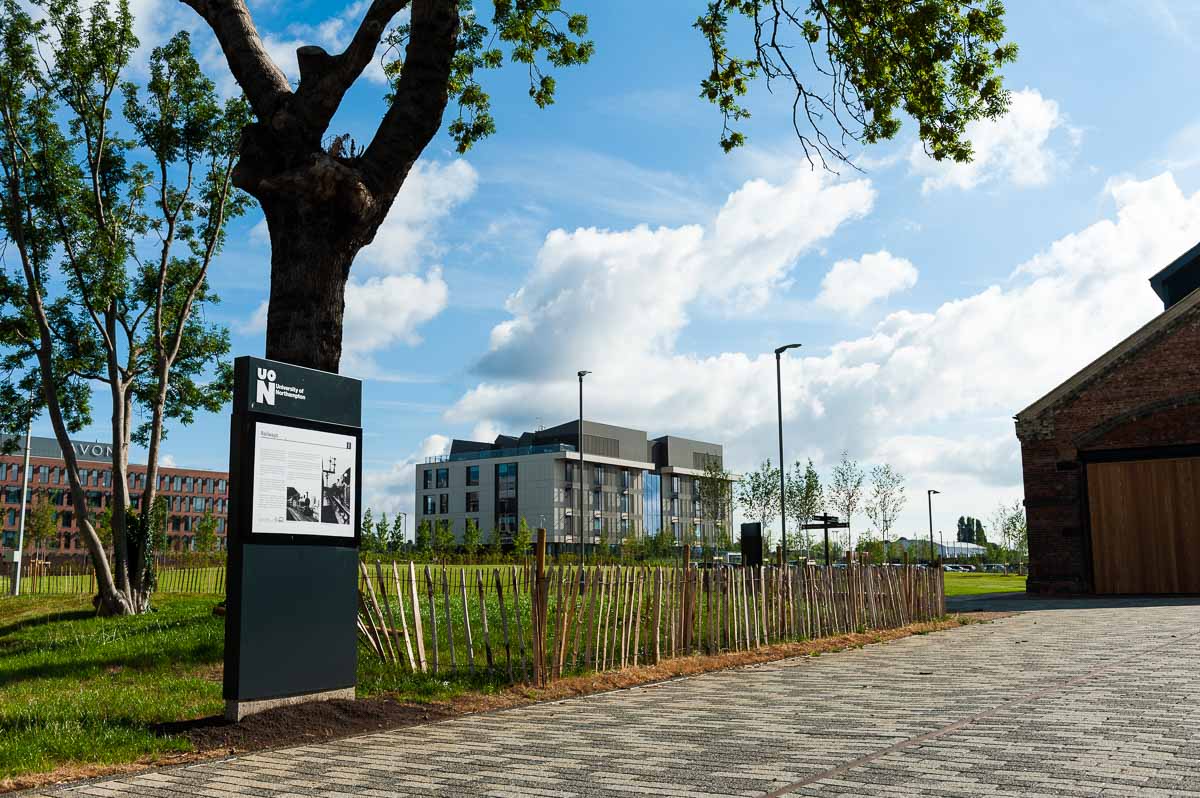Battlefields, jet engines, locomotives and power – heritage signs bring Waterside Campus’s history to life
Date 5.10.2018

The hidden history of the University of Northampton’s new home has been revealed – and it includes stories of warring armies, jet engine testing, railway history and defences against Nazi invasion.
The new £330m town centre Waterside Campus is built on land with a rich heritage, including being the location of the Battle of Northampton, a power station which was also used to test jet engines, the home of an historic engine shed and a place with Second World War fortifications.
The stories behind the site have been brought to life on a series of information boards at Waterside.
The text on each board, which also includes information on the site’s biodiversity and the neighbouring headquarters of cosmetics firm Avon, has been reproduced below.
The Engine Shed and Office
Built in 1873 to service and repair steam railway engines, part of The Engine Shed is still standing today. It would have been used to house four locomotives for servicing and repairs. It closed in 1924 but was used as a welding school from 1965. It has since been listed as a Grade II listed building in 1995 and remained in use until 1998. It’s now a part of the University’s student union, having been given a sympathetic renovation.
Northampton Power Station
The Northampton Electric Light and Power Station was opening in 1889, serving domestic and business customers. Having outgrown its Northampton home at Angel Lane, it moved to land at Hardingstone Junction, becoming the Nunn Mills power station in 1915. The power station had many uses, one of which being to test jet engines. The power station was brought under the Central Electricity Board (CEB) in the 1930s, providing electricity for the National Grid. That made it a target during German bombing raids, but the site survived. Nunn Mills closed in 1975 and was demolished in 1979.
World War Two Pillbox
Two pillboxes were positioned near the Nunn Mills Power Station as part of defence against Nazi invasion. The pillboxes were made of concrete, with an open-roof design. By September 1941, Northampton became a ‘nodal point’. These key positions were to be tightly defended in case of German invasion. Keeping the Nunns Mill Power Station running, and other power stations running, was an important part of generating electricity to help in the war effort. The site was regularly used for training purposes.
Avon Cosmetics
Avon launched in the UK in Northampton in 1959, quickly becoming synonymous up and down the country. Between 1989 and 2004 Avon had a manufacturing facility on the site, now housing the new University campus. Avon’s current UK headquarters is next to the campus, having been there since 2009. Avon is proud if its heritage of helping to improve lives, having been involved in many charitable causes.
Ecology at Waterside Campus
The biodiversity of Waterside Campus was a fundamental part of the planning of the University’s new site. Some of the natural habitat has been protected and some habitat has been created, including planting species that attract insects and pollinators, which in turn attracts birds, bats and other wildlife. The new Ecology Zone, created in 2017, uses natural soils and substrates to create a varied habitat for wildlife. In 2018, expect to see otters, heron, kingfisher, wetland birds, bats, dragonflies, butterflies and bees.
The information and photos used on the boards were kindly provided by Northamptonshire Battlefields Society, Heritage Lottery Fund, Northampton Museums and Art Gallery, Avon, Destination Nene Valley and LUC.
The information boards and the signs that feature throughout the campus have been designed, manufactured and installed by dlinexsign, appointed by contractors Bowmer and Kirkland.